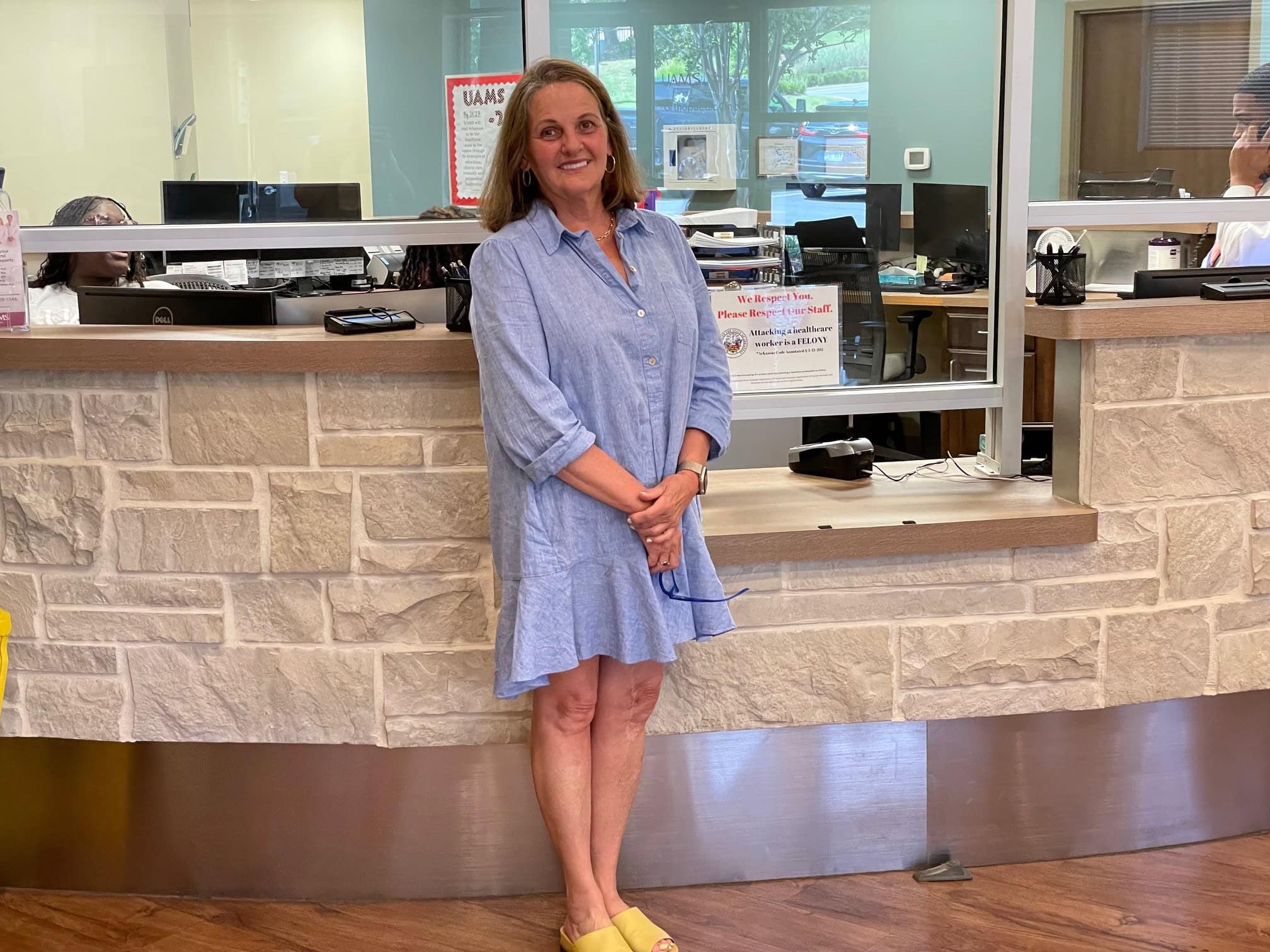Memphis Doctor Becomes First Mazor Robot Patient at UAMS’ Orthopaedic & Spine Hospital
| Memphis OB-GYN Lea Bannister was so excited about buying a fancy new carbon-fiber bicycle that the first time she rode it, she didn’t stop pedaling for 25 miles.
It was the first time she had ridden a bike in several years, however, and at age 61, she was prone to osteoarthritis. She had already undergone a right hip replacement, and 36 years earlier, after being hit by a car while celebrating Mardi Gras, she had undergone knee surgery as well.
“I overdid it,” she acknowledged about the bike ride. “I did myself in from the get-go.”
Bannister said she realized that when, immediately after the bike ride, she began experiencing pain in her left buttock and lower back.
“It hurt, hurt, hurt,” she said. Though she continued to work and see patients, “I moaned all the time getting up from my desk.”
At first, she thought it was bursitis, an inflammatory condition. But even after receiving two epidural steroid injections within six weeks of the July 2023 bike ride, the pain persisted.
It wasn’t until Bannister traveled to Little Rock in December to undergo minimally invasive surgery at the hands of David Bumpass, M.D., a nationally recognized orthopaedic spine surgeon, that she finally experienced relief. The surgery was performed Dec. 13, 2023, at The Orthopaedic & Spine Hospital at the University of Arkansas for Medical Sciences (UAMS), where Bumpass, an associate professor in the College of Medicine, co-directs spine services.
He was highly recommended by Dmitri Falkner, M.D., then a third-year orthopaedic resident at UAMS who plans to marry Bannister’s daughter in the fall. Meanwhile, Isabel Bannister, a recent graduate of the University of Tennessee, plans to join the UAMS surgical hospital as a certified registered nurse anesthetist (CRNA) this fall.
Bumpass said Bannister had spinal spondylolisthesis, a fairly common degenerative condition in which a vertebra slips forward onto the bone below it, compressing or “pinching” nerve roots and causing severe lower back pain or leg pain. The compression occurred on the left side of Bannister’s spine, between her L-4 and L-5 vertebrae.
“I blame it on imbalance,” Bannister said, explaining that since her hip replacement and knee surgery, “I was living on my left side,” overcompensating for pain on her right side.
Bumpass said Bannister’s condition created the perfect opportunity for UAMS’ first use of its new Mazor robot. The Medtronic product, which isn’t available at all medical centers, is a sophisticated guidance system for spinal surgery that includes pre- and intraoperative planning.
“It lets us be much more minimally invasive,” Bumpass said. “It has an extremely high level of accuracy. In fact, it has validated accuracy within 1 millimeter, while still allowing us to be minimally invasive.”
Bumpass said he began the surgery on the anesthetized physician through two small incisions parallel to the midline as she lay face down. A preoperative CT scan that was synced with the robotic guidance system ensured precision as he inserted four screws, two rods and a spacer, while also removing some bone to alleviate spinal stenosis. It took about 2 ½ hours altogether.
Bannister spent that night in the hospital and went home the following day. Three weeks later, she was back at work, limited to half-days and office duties. Then, six weeks after the surgery, she had returned to her regular duties of delivering babies.
Six months later, she is able to participate again in activities like swimming and walking her dogs. She hasn’t yet resumed long bike rides, but is using her stationary bicycle, anticipating the day she can get back on the fancy bike she bought last year.
Bannister is also singing the praises of Bumpass, UAMS and the Mazor robot.
“I love The Orthopaedic & Spine Hospital,” she said. “It was a draw.”
She explained that shortly after the four-story, 158,000-square-foot surgical facility opened in June 2023, “I brought my aunt, who is in her 80s, up here for a foot procedure,” and was impressed.
When it became inevitable that she would need surgery to fix her spinal spondylolisthesis, she said, “I went in hoping I was a candidate for a more minimally invasive type thing,” and was thrilled to be the first Mazor Robotic Systems patient at UAMS.
“I’m a happy customer,” she said. “And I was pleased with all the care I got from everyone.”
She is excited about attending the September wedding of her daughter and Falkner at Glacier National Park in Montana, described as “a paradise for adventurous visitors,” and doing her share of hiking — if not some cycling.

